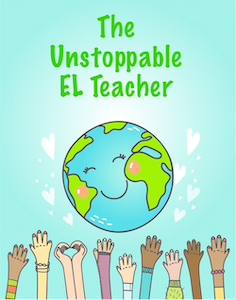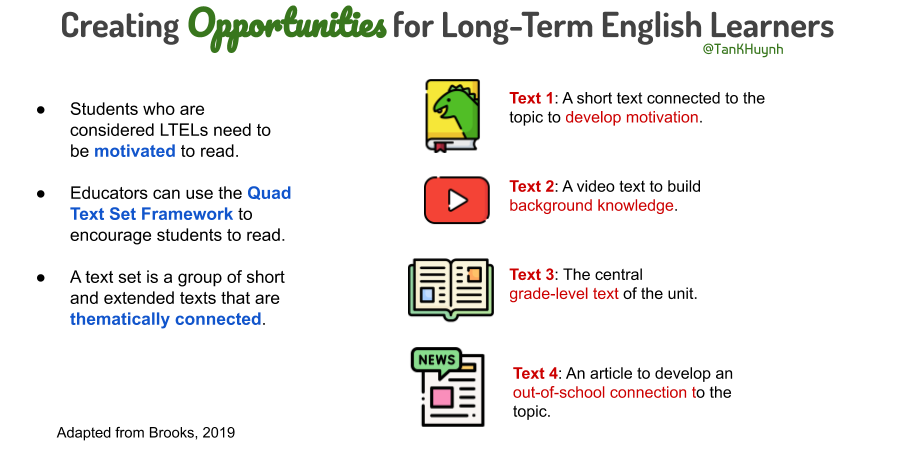How to engage (not label) long-term English learners
A MiddleWeb Blog
Labels can be dangerous. I have to confess that I previously used the label “long-term English learners” (LTELs) to categorize students who had received intensive language support for five or more years.
But after my podcast interview with Dr. Maneka D. Brooks, author of Transforming Literacy Education for Long-Term English Learners (2019), I now realize that some identification labels can mask what students are able to do.

Dr. Brooks
Brooks explains that LTEL is a terminology rooted in school policy language. Such policies label students this way through a combination of factors, such as years spent in English-dominant schools, language spoken at home, and assessment results (Brooks, 2019).
However, this term is problematic because it:
➜ ignores students’ engagement
➜ erases the value of out-of-school literacy abilities
➜ overlooks the complexity of language and literacy
➜ does not consider how lessons create context or relevancy for students
The term “LTELs” carries a negative message: What is wrong with you? You have been immersed in English all this time, but you are still not proficient. Instead, Brooks recommends this phrasing – “Students who are considered LTELs” – which communicates that you recognize the label is in common use, but you are distancing yourself from it. (Another option is to simply use the students’ names when talking about their needs.)
Low-engagement activities fail to motivate struggling students
For her dissertation and book research, Brooks observed five Latina students for a year as they went to school. She also interviewed the girls about what she saw in their classes. The girls reported that learning experiences that did not engage them were ones that had them consume information rather than create using content knowledge and language skills (2019).
Some of these unengaging, passive activities included:
✘ Reading from a presentation slide
✘ Popcorn or Round Robin reading
✘ Listening to a lecture for the entire duration of the period
✘ Engaging in repetitive experiences across classes (e.g., taking notes during a lecture)
Students who did not engage in these activities were often talked about as having a “failure to learn.” Instead, Brooks suggests changing the narrative around students who are considered LTELs.
When working with students labeled as LTELs, she argues, success or failure is less about their inability to learn and more about creating engaging opportunities to learn (Brooks, 2019).
Creating an engaging context with text sets
Students are better served when we create a context that motivates students to learn. Context is like clay that teachers can mold or a space that inspires students to learn. Using the Text Set strategy is one way to create a context that motivates students to engage (Brooks, 2019).
A text set is a group of texts all connected to a single topic. A text set consists of:
✔︎ A central, grade-level text of the unit and
✔︎ A series of shorter texts
The goal of a text set is to have students engage in reading grade-level texts but also to build background knowledge, provide an example for life outside of school, foster a deeper understanding of the concept or topic, and motivate them to read. The shorter texts can be videos, poems, quotes, picture books, infographics, articles, photos, drawings, demonstrations, simulations, or anything that connects to the unit’s concept or topic.
The key for these texts to be effective is that they are easily consumable so that they leave time for students to engage in conversations around their ideas. A type of text set that Brooks recommended is called Quad Text Set (Lupo, Strong, Lewis, Walpole, & McKeena, 2018). In this model, there are four unique texts, and each text serves a different purpose. However, each text is directly linked to a central topic.
Let’s say, for example, you are planning on using Romeo and Juliet to teach literary analysis. One of the central concepts in the drama is relationships. A text set might be as follows:
Text 1 – to engage students: A news broadcast about how teens who do not date are less depressed than those who do.
Text 2 – to build background knowledge: An article that summarizes recent findings around teens and dating.
Text 3 – to align with the standards and curriculum: Romeo and Juliet.
Text 4 – to connect the concept to an example: A TED Talk video by a psychologist talking about skills for a healthy romantic relationship.
Fostering meaningful contexts for reading
Another way to create opportunities to learn for students who are considered LTELs is to form strong connections between their lives and the content. We saw that in the text set example with Romeo and Juliet, and we can do that in any content area.
The four ways you can form a connection between the content and students’ lives are:
✔︎ Content to self: How does the content show up in their individual lives?
✔︎ Content to home: How does the content show up in the lives of their relatives and immediate family members?
✔︎ Content to community: How does the content show up for their community or culture?
✔︎ Content to the world: How does the content show up between nations?
The goal of creating a meaningful connection is to shift the narrative around what we learn. We move away from saying “You have to learn this” to saying “This connects to your life, so let’s learn about it.”
But connection alone is just the first phase of anchoring students within a context that stimulates learning. The second part is to create a space where students can contribute their ideas. This means not simply memorizing and repeating content knowledge, but instead using content knowledge, skills, and language to:
• Test a theory
• Solve problems
• Defend a position
• Raise awareness
• Create a product
• Establish a process
• Collaborate with others on a project
For more ideas on how to create with and apply content, check out my blog post Creating with Content: Moving Beyond Memorizing to Applying.
Conclusion
This interview with Dr. Brooks has been so insightful! I used to think that students whom I formerly called LTELs were lacking in English literacy abilities, and it was up to us to finally address these deficits. Dr. Brooks has convinced me that – excluding cognitive processing needs – students will engage if we can create a meaningful context that inspires participation. With engagement, they will use language for authentic purposes. For some language learners, they do not develop their skill UNLESS the task motivates them to engage.
Therefore it is up to us to create the context needed to motivate students. The good news is that the ability to create a context for learning rests securely within our hands.
References
Lupo, S. M., Strong, J. Z., Lewis, W., Walpole, S., & McKenna, M. C. (2018). Building background knowledge through reading: Rethinking text sets. Journal of Adolescent and Adult Literacy, 61(4), 433–444.
Brooks, M. D. (2019). Transforming Literacy Education for Long-Term English Learners: Recognizing brilliance in the undervalued. New York, NY: Routledge, Taylor & Francis Group.




































